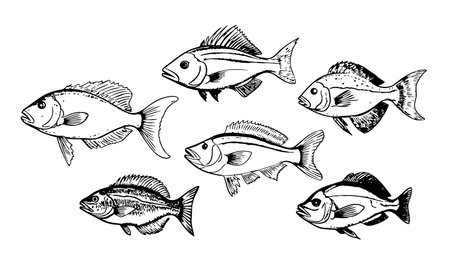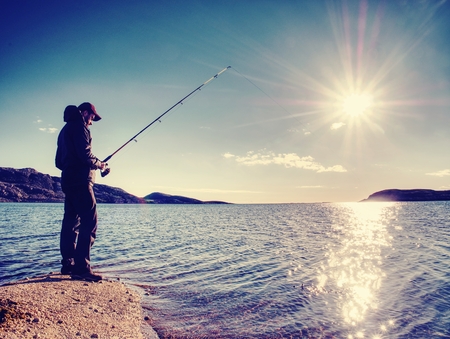Introduction to U.S. Fishing Regulations
Fishing has always played a significant role in American culture and the economy, from the early days of Native American communities to today’s thriving commercial and recreational industries. However, as fishing activities grew in scale and popularity, concerns over depleted fish stocks and environmental impacts became increasingly urgent. This led to the development of fishing regulations across the United States, designed to protect marine resources while supporting local economies. The core purpose of these regulations is to strike a balance between conservation—ensuring that fish populations remain healthy for future generations—and economic interests, which rely on sustained access to fisheries for jobs and commerce. Over time, U.S. fishing policies have evolved in response to scientific research, technological advances, and shifting public priorities, reflecting a continual effort to harmonize environmental stewardship with economic opportunity.
2. Historical Development of Fishing Laws
The history of fishing regulations in the United States is a fascinating journey that mirrors the nation’s growth and changing relationship with its natural resources. In the earliest days, American fisheries were largely unregulated, as settlers and Indigenous peoples relied on abundant fish stocks for both sustenance and trade. However, by the late 19th century, overfishing and industrialization began to threaten these valuable resources, prompting state governments to enact the first fishing laws. These early efforts focused mainly on protecting local stocks through seasonal closures and gear restrictions.
Key Milestones in U.S. Fishing Regulation
| Year | Milestone | Impact |
|---|---|---|
| 1871 | Establishment of the U.S. Fish Commission | First federal effort to study and manage declining fish populations |
| 1950 | Pittman-Robertson Act Extension (Federal Aid in Sport Fish Restoration) | Provided funding for state fisheries conservation, research, and access projects |
| 1976 | Magnuson-Stevens Fishery Conservation and Management Act | Created regional management councils and extended U.S. jurisdiction to 200 miles offshore, focusing on sustainable fisheries management |
| 1996 | Sustainable Fisheries Act Amendments | Mandated rebuilding of overfished stocks and introduced stricter conservation measures |
The Early Regulatory Landscape
In the early 20th century, states played a leading role in managing inland and coastal fisheries, often imposing license requirements and establishing game wardens. However, as fishing technology advanced and demand grew, state boundaries proved inadequate for managing migratory species like salmon or striped bass. This realization led to more coordinated regional and federal action.
The Shift Toward Federal Oversight
The post-World War II boom in commercial fishing further highlighted the need for comprehensive regulation. The Magnuson-Stevens Act of 1976 marked a turning point by establishing national standards for sustainable fisheries management and creating regional councils that included stakeholders from diverse backgrounds—commercial fishermen, scientists, conservationists, and government officials.
Together, these milestones reflect how U.S. fishing laws have evolved from patchwork state rules to an integrated system focused on sustainability, science-based management, and stakeholder involvement—a foundation that continues to shape policy today.

3. Federal vs. State Authority
When it comes to fishing regulations in the United States, one of the most complex and debated aspects is the division of authority between federal and state governments. This dual system has evolved over time, as both levels of government have carved out distinct but sometimes overlapping roles in managing fisheries and conserving aquatic resources. The federal government, primarily through agencies like the National Oceanic and Atmospheric Administration (NOAA), oversees marine fisheries that occur beyond state waters—generally three nautical miles from shore on the Atlantic and Pacific coasts, and nine miles off Texas, Florida’s Gulf coast, and Puerto Rico. These federal waters are governed by comprehensive laws such as the Magnuson-Stevens Fishery Conservation and Management Act, which aims to prevent overfishing, rebuild depleted stocks, and ensure sustainable use.
On the other hand, state governments regulate fishing activities within their own territorial waters, setting rules for freshwater bodies and nearshore marine environments. Each state’s fish and wildlife agency develops regulations tailored to local conditions, including licensing requirements, bag limits, seasons, and gear restrictions. This can lead to significant variation in rules across state lines—even for the same species—reflecting differences in fish populations, ecological concerns, cultural practices, and economic priorities.
The implications of this shared authority are significant for both recreational anglers and commercial operators. For those who fish recreationally, it means understanding a patchwork of regulations that may change drastically as you move from one jurisdiction to another; what’s legal in Florida might not be allowed just a few miles north in Georgia. Commercial operators face even greater complexity as they navigate overlapping permitting processes and compliance checks at both state and federal levels. This regulatory mosaic can create challenges but also provides opportunities for more locally responsive management.
Ultimately, the partnership between federal and state authorities is crucial for effective fisheries management. While it can sometimes result in bureaucratic hurdles or confusion for stakeholders, it also allows for flexible approaches that address both national conservation goals and local needs. As U.S. fishing policies continue to evolve, finding ways to harmonize these different layers of governance will remain a central issue for regulators and everyone who depends on healthy fisheries.
4. Key Legislation and Landmark Cases
The evolution of U.S. fishing regulations has been heavily shaped by critical legislation and landmark legal cases that have set the tone for how fisheries are managed today. Among the most pivotal laws is the Magnuson-Stevens Fishery Conservation and Management Act (MSA) of 1976, which established the foundation for federal oversight of fisheries in U.S. waters. This act extended American jurisdiction to 200 nautical miles offshore, establishing Exclusive Economic Zones (EEZs), and created eight regional fishery management councils to oversee sustainable practices.
Major Laws Influencing U.S. Fisheries
| Name of Law | Year Enacted | Main Impact |
|---|---|---|
| Magnuson-Stevens Act | 1976 | Established EEZs and regional management councils; focus on sustainability |
| Marine Mammal Protection Act | 1972 | Protected marine mammals from overfishing and bycatch |
| Endangered Species Act | 1973 | Provided protections for threatened and endangered aquatic species |
Landmark Legal Battles
Several court cases have also played a significant role in shaping policy. For example, Lorenz v. United States (1980) clarified the governments ability to regulate within the EEZ, reinforcing federal authority over state interests. Another notable case, Maine v. Kreps (1978), addressed states rights versus federal management when it came to allocating resources and setting catch limits.
The Ongoing Influence of Key Decisions
These laws and decisions collectively ensure that U.S. fisheries are managed with an eye toward conservation, fair allocation, and adaptation to new scientific knowledge. By balancing economic needs with environmental responsibility, they continue to shape the trajectory of fishing policy across the nation.
5. Recent Changes and Current Challenges
In recent years, U.S. fishing regulations have undergone significant updates to address emerging challenges and shifting priorities in marine management. One of the most notable changes has been the revision of catch limits and quotas based on new scientific data, reflecting a stronger commitment to sustainable fishing practices. These adjustments are often contentious, as commercial and recreational fishers sometimes perceive them as threats to their livelihoods or traditional ways of life. At the same time, regulatory bodies like NOAA Fisheries have implemented more rigorous monitoring and enforcement protocols, incorporating advanced technology such as electronic logbooks and satellite tracking to improve compliance and data accuracy.
Climate change presents an unprecedented challenge for regulators. Rising ocean temperatures and shifting habitats are forcing policymakers to reconsider species protections, habitat designations, and seasonal closures. Fish populations are migrating northward or into deeper waters, disrupting established fisheries and complicating stock assessments. Overfishing remains a persistent problem, particularly for highly sought-after species like Atlantic cod and bluefin tuna. The need to balance economic interests with conservation goals has led to heated debates over the allocation of limited resources, bycatch reduction measures, and the role of marine protected areas.
Additionally, stakeholder conflicts have intensified as more groups—such as indigenous communities, environmental advocates, commercial operators, and recreational anglers—vie for influence in policy decisions. The rise of ecosystem-based management approaches signals a shift toward considering the broader impacts of fishing on entire marine systems rather than just individual species. However, implementing these holistic strategies is complex and requires robust scientific collaboration and adaptive governance frameworks.
Ultimately, recent regulatory changes reflect an evolving understanding of marine ecosystems and a recognition that past management approaches must adapt to new realities. The interplay between environmental pressures, technological advancements, and stakeholder interests will continue to shape U.S. fishing regulations in the coming years.
6. Technological Innovations in Fisheries Management
Over the past several decades, technological innovation has become a cornerstone in the evolution of U.S. fishing regulations. Modern tools are not only changing how fisheries are managed but also boosting enforcement, monitoring, and sustainability efforts nationwide. With increasing pressure on marine resources and growing awareness about environmental impacts, technology is helping regulators keep pace with the complex realities of today’s fisheries.
Enforcement Goes High-Tech
In the United States, enforcing fishing regulations has traditionally been challenging due to the sheer scale of coastal waters and limited manpower. However, recent advancements such as satellite tracking systems, electronic logbooks, and vessel monitoring systems (VMS) have dramatically improved oversight. Agencies like NOAA now use these technologies to track commercial fishing vessels in real time, ensuring compliance with catch limits and closed areas. These tools help reduce illegal fishing activities and make it easier to identify potential violations quickly and efficiently.
Data-Driven Monitoring
The integration of electronic monitoring systems—such as onboard cameras and automated sensors—is revolutionizing how fish stocks are monitored. These innovations provide accurate data on catch volumes, bycatch rates, and species composition without relying solely on human observers. This shift toward data-driven management enables more precise stock assessments and supports science-based decision-making for quota setting and conservation measures.
Supporting Sustainability Initiatives
Technology is also empowering sustainable practices within the fishing industry. Mobile apps for recreational anglers allow instant reporting of catches, which helps managers get real-time information on fish populations and adapt regulations as needed. Additionally, advances in gear technology—like turtle excluder devices or selective nets—help reduce unintended bycatch and protect endangered species while maintaining commercial viability.
Looking Ahead: The Future of Tech in Fisheries
As artificial intelligence, machine learning, and blockchain technologies gain traction, their applications in fisheries management are expected to expand further. Predictive modeling can forecast stock fluctuations, while secure digital ledgers may soon track seafood from ocean to table—enhancing traceability and consumer confidence. Ultimately, the continued evolution of technology promises to strengthen regulatory frameworks, support ecosystem health, and ensure that America’s fisheries remain both productive and sustainable for generations to come.
7. Predictions and Future Trends
Looking ahead, the evolution of U.S. fishing regulations will likely be shaped by a dynamic interplay of scientific research, public advocacy, and global environmental trends. As technology advances, data-driven management is expected to become more precise, with real-time monitoring of fish stocks and ecosystem health informing adaptive regulations. This science-based approach will empower agencies to respond swiftly to population changes or emerging threats, such as climate-driven shifts in species distribution.
Public advocacy is also anticipated to play a critical role in shaping future policies. With growing awareness about marine conservation and sustainable seafood practices, grassroots movements and nonprofit organizations are increasingly influencing legislation at both state and federal levels. Expect to see more stakeholder engagement processes, where recreational anglers, commercial fishers, indigenous groups, and environmentalists collaborate on policy decisions.
Globally, the U.S. will continue to align its fisheries management with international standards and agreements. Issues like illegal, unreported, and unregulated (IUU) fishing will spur tighter import controls and traceability requirements for seafood products. Moreover, as ocean ecosystems face mounting pressure from warming waters and ocean acidification, regulations may expand to address carbon emissions related to the fishing industry itself.
In the coming decades, we can anticipate a move towards ecosystem-based management—regulating not just individual species but the broader habitats and food webs they depend on. Innovations such as electronic reporting tools, satellite tracking of vessels, and AI-powered analysis of catch data could further revolutionize compliance and enforcement efforts.
Ultimately, the future of U.S. fishing regulations will be characterized by flexibility, inclusivity, and resilience—adapting not only to new scientific insights but also to the voices of local communities and the demands of a changing planet. As Americans look to balance cultural traditions with ecological responsibility, forward-thinking regulation will be essential to ensure healthy fisheries for generations to come.


